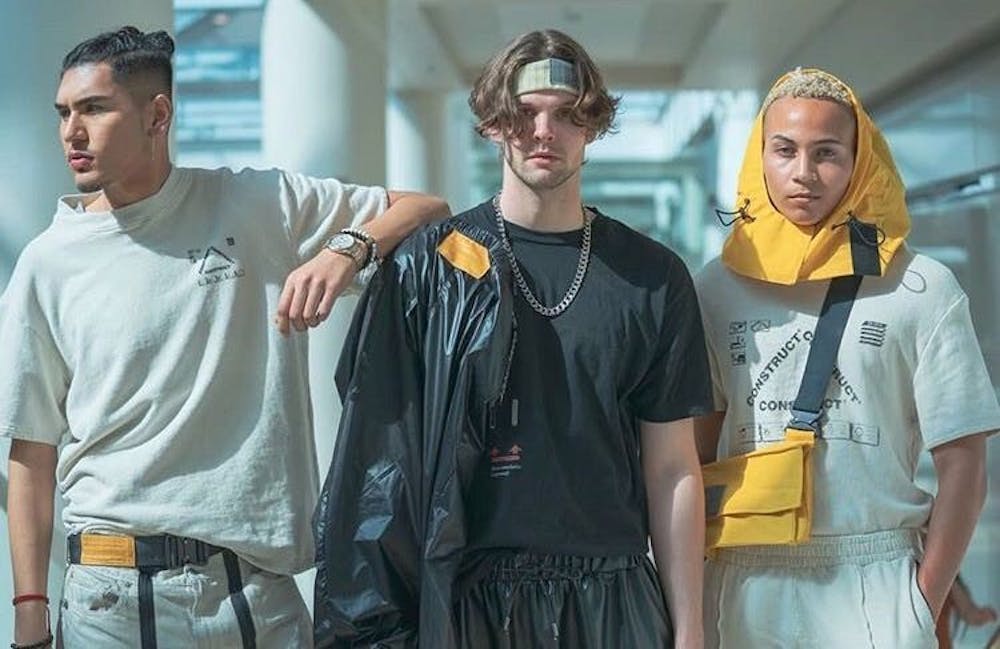The remnants of leftover tents from FORM, a music festival held in Arcosanti, Arizona, sit in a bin in ASU alumnus Connor Damaschi’s shed.
Organized around it are more bins filled with old parachutes, shredded wall, tarp and miscellaneous fabrics from thrift stores. The extensive collection of material is what Damaschi utilizes as textiles for Yellow Zone, his developing fashion project created on the idea of sustainability and recycling in modern streetwear.
“Everything already exists. We already have it all," Damaschi said. "We just need to repurpose, remake it, deconstruct it.”
Damaschi uses recycled material when constructing his designs but not what most think of as typical clothing fabric. Tarps, tents, plastics and even discarded Amazon envelopes have been incorporated into his designs to create an eco-conscious streetwear label that essentially wastes nothing in the production process.
His latest line premiered at the Uncertainty Fashion Show at Scottsdale Fashion Square Mall on March 30, 2019, and he showed off fabric samples and swatches that he recycled.
“These were a couple of raincoats from Goodwill that were kind of destroyed and probably destined for the landfill,” Damaschi explained. “I cut them up, took what fabric I could and turned them into a bag and hood.”
Damaschi bases his brand on what he calls a “trash aesthetic.” From a young age, he said he has always been interested in waste outputs and holding onto discarded items to create something new out of them.
He first began to conceptualize the idea for Yellow Zone in August, 2018 and developed it throughout his senior year at ASU. His first sample was a cut-and-sew piece of denim laminated with recycled polyvinyl chloride material to make it waterproof.
Damaschi said the concept of layering is the focal point of his design process. With a background in architecture, engineering and painting, his process is influenced by both traditional design principles and his own creative direction.
“Wherever I go, I’m always taking in all of this data and subconsciously analyzing and picking it apart from an engineering, sculptural perspective,” Damaschi said.
From an early age, he was interested in design but more so in painting and architecture. Damaschi also said his upbringing played a role in the development of Yellow Zone.
“Both of my parents were engineers, they work for the Navy,” Damaschi said. “Growing up, we were moving around, going to places like Italy, Spain, Europe, Hawaii. After that, my outlook was always focused on construction, engineering, architecture.”
Damaschi originally wanted to become an architect. He took a number of fashion classes and gradually became interested in high fashion and modern streetwear culture. He developed the concept behind Yellow Zone with not only a vision of design and functionality but a social message too.
The current state of streetwear, heavily based on trends and hype, thrives off of “FOMO” and consumer anxiety, Damaschi said. Streetwear brands base their designs on what is popular in the moment — a model that ultimately generates lots of waste in terms of production and fabric.
“It’s all about creating that anxiety, manufacturing that need to buy,” Damaschi said. “I want to take that model, but flip it on its head and put a mirror in front of it.”
Damaschi said he wants Yellow Zone to be something that is individualistic; not only to his vision but to fashion culture in general.
“What I am trying to create is my own version of high-end conceptual infused streetwear, and there’s a lot of context points and influences into that,” Damaschi said.
The idea of a clothing brand being high-end while made up of what is essentially all trash seems ironic, but recycling in fashion has gained popularity in the past few years, with large brands like Nike and Adidas giving the concept a try. Damaschi said he sees today’s high-end fashion brands moving forward with more sustainable design concepts in the future, and he wants to help.
A large part of Damaschi’s journey and inspiration in sustainability has been his time spent at Arcosanti, an experimental community of just under 100 residents working toward implementing new concepts in sustainability and waste management.
Read more: Greenlight Solutions and Arcosanti residents are working toward a sustainable future
Damaschi helped develop the beginning of a zero-waste system in Arcosanti and worked alongside Arcosanti's chief officer of marketing and technology, Rob Jameson, in a number of projects related to innovation in recycling and waste management.
“Arcosanti is sort of a second or third home to me,” Damaschi said. “It’s a really special place.”
Damaschi said a lot of his next pieces will include textiles and materials sourced from Arcosanti and its new-found circular economy.
Damaschi said, although Yellow Zone has received tons of positive feedback, it is still early in the development and research stages. He plans on having a website with 10 made-to-order items by the end of the year but is taking his time in research and brand development.
"This is 1%. This is literally 1% of the vision, the goal, what’s to come," Damaschi said. "That’s something that inspires me and has motivated me to keep going."
Editor's note: Due to a reporting error, a previous version of this article misquoted a source. The erroneous reporting has been deleted.
Reach the reporter at mmbarbe3@asu.edu and follow @meganbarbera on Twitter.
Like State Press Magazine on Facebook and follow @statepressmag on Twitter.




